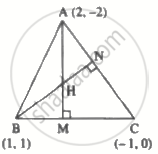Advertisements
Advertisements
Question
Find the coordinates of the orthocenter of the triangle whose vertices are A(2, −2), B(1, 1), and C(−1, 0).
Solution

Let AM and BN be the altitudes of the ΔABC.
Now, slope of BC = `(0 - 1)/(-1 - 1) = 1/2`
Altitude AM a perpendicular to side BC.
∴ slope of altitude AM = –2 and it is passing through A(2, –2).
∴ equation of the altitude AM is y – (–2) = –2(x – 2)
∴ y + 2 = –2x + 4
∴ 2x + y = 2 ....(1)
Slope of side AC = `(0 - (- 2))/(-1 - 2) = -2/3`
Altitude BN is perpendicular to side AC.
∴ slope of altitude BN = `3/2` and it is passing through B (1, 1).
∴ equation of the altitude BN is
y – 1 = `3/2(x - 1)`
∴ 2y – 2 = 3x – 3
∴ 3x – 2y = 1 ....(2)
The orthocentre H is the point of intersection of the altitudes AM and BN. Hence, we solve equations (1) and (2).
Multiply equation (1) by 2, we get,
4x + 2y = 4 ...(3)
Adding (2) and (3), we get,
3x – 2y = 1
+ 4x + 2y = 4
7x = 5
∴ x = `5/7`
∴ from (1), `2(5/7) + y` = 2
∴ y = `2 - 10/7`
= `4/7`
Hence, coordinates of orthocentre H are `(5/7, 4/7)`.
APPEARS IN
RELATED QUESTIONS
Write the equation of the line :
parallel to the X−axis and at a distance of 5 unit form it and above it
Write the equation of the line :
parallel to the Y−axis and at a distance of 5 unit form it and to the left of it
Obtain the equation of the line :
parallel to the Y−axis and making an intercept of 4 unit on the X−axis
Obtain the equation of the line containing the point :
A(2, – 3) and parallel to the Y−axis
Find the equation of the line passing through the points P(2, 1) and Q(2, –1)
Find the equation of the line passing through the origin and parallel to AB, where A is (2, 4) and B is (1, 7)
Find the equation of the line containing point A(4, 3) and having inclination 120°
Line y = mx + c passes through points A(2, 1) and B(3, 2). Determine m and c.
The vertices of a triangle are A(3, 4), B(2, 0), and C(−1, 6). Find the equation of the line containing side BC.
The vertices of a triangle are A(3, 4), B(2, 0), and C(−1, 6). Find the equation of the line containing the median AD
Find the x and y intercept of the following line:
`(3x)/2 + (2y)/3` = 1
Find equations of lines which contains the point A(1, 3) and the sum of whose intercepts on the coordinate axes is zero.
Find equations of lines containing the point A(3, 4) and making equal intercepts on the co-ordinates axes.
Find equations of altitudes of the triangle whose vertices are A(2, 5), B(6, –1) and C(–4, –3).
Find the equations of perpendicular bisectors of sides of the triangle whose vertices are P(−1, 8), Q(4, −2), and R(−5, −3)
N(3, −4) is the foot of the perpendicular drawn from the origin to line L. Find the equation of line L.
Select the correct option from the given alternatives:
If the point (1, 1) lies on the line passing through the points (a, 0) and (0, b), then `1/"a" + 1/"b"` =
Answer the following question:
Obtain the equation of the line containing the point (2, 3) and parallel to the X-axis.
Answer the following question:
Obtain the equation of the line containing the point (2, 4) and perpendicular to the Y−axis
Answer the following question:
Find the equation of the line having slope 5 and containing point A(–1, 2).
Answer the following question:
The vertices of a triangle are A(1, 4), B(2, 3) and C(1, 6) Find equations of Perpendicular bisectors of sides
Answer the following question:
Find the Y-intercept of the line whose slope is 4 and which has X intercept 5
Answer the following question:
A(1, 4), B(2, 3) and C(1, 6) are vertices of ∆ABC. Find the equation of the altitude through B and hence find the co-ordinates of the point where this altitude cuts the side AC of ∆ABC.
Answer the following question:
Show that there are two lines which pass through A(3, 4) and the sum of whose intercepts is zero.
The lines `(x + 1)/(-10) = (y + 3)/-1 = (z - 4)/1` and `(x + 10)/(-1) = (y + 1)/-3 = (z - 1)/4` intersect at the point ______
The slope of normal to the curve x = `sqrt"t"` and y = `"t" - 1/sqrt"t"`at t = 4 is _____.
The intercept of a line between the coordinate axes is divided by the point (1, 3) in the ratio 3 : 1. The equation of the line will be ______
A Plane cuts the coordinate axes X, Y, Z at A, B, C respectively such that the centroid of the Δ ABC is (6, 6, 3). Then the equation of that plane is ______.
Suppose the line `(x - 2)/α = ("y" - 2)/(-5) = ("z" + 2)/2` lies on the plane x + 3y – 2z + β = 0. Then (α + β) is equal to ______.
